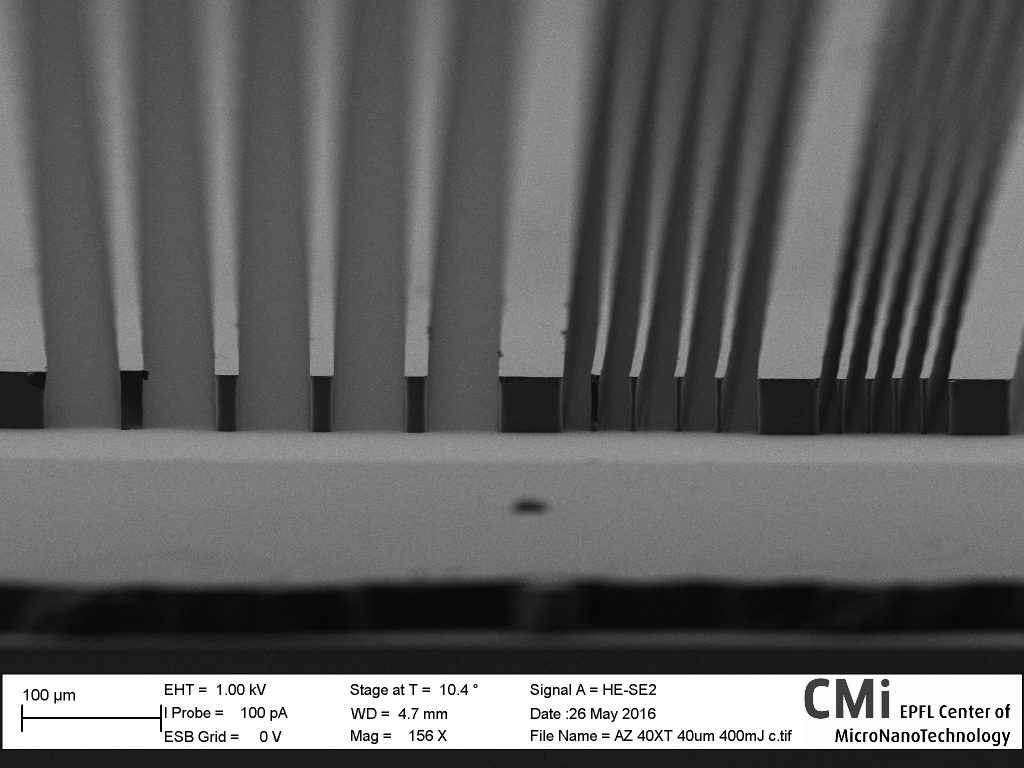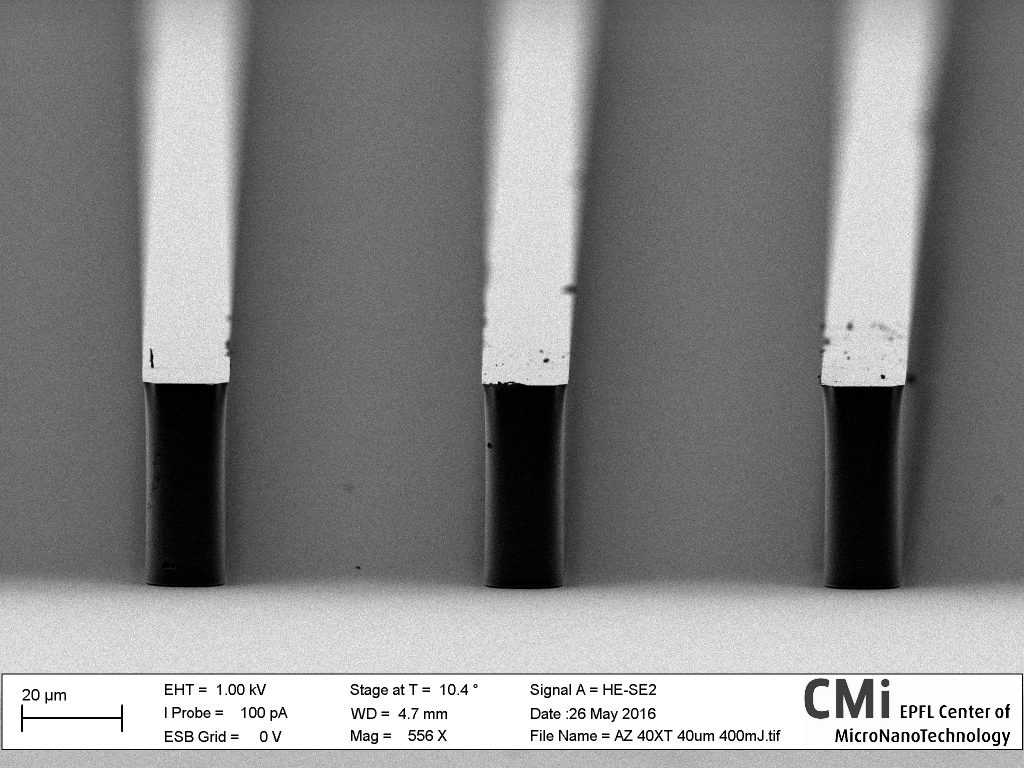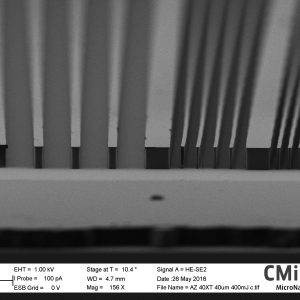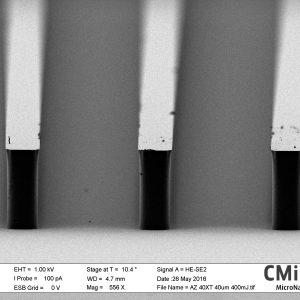AZ 40XT is a chemically amplified ultrathick positive photoresist, requiring low exposure doses and with high development rate. The field of applications of the resist starts at 15-30 µm, where photolithography processes with conventional positive resists become very time-consuming due to increasing delays for rehydratation or N2-outgassing, both not required for this resist. This resist is recommended for silicon deep etching and electroplating.
- Coating Tools : ACS 200; Sawatec SM-200
- Thickness range [µm]: 10 … 40
- Minimum CD / typical aspect ratio: ~ 3um / AR ~ 4:1
- Substrate topography: High
- Recommended for: Dry etching (depth up to 500+ um, vias), electroplating, molding
Process in CMi
! Cleanroom humidity warning !
Control of the relative humidity (RH) in photolithography zones is extremely critical. Stable and reproducible photolithography is expected within 38% to 48% RH range.
- In case of low RH (< 38%), the resist sensitivity and development rate decreases. It is then recommended to increase the recommended exposure doses.
- In case of high RH (> 48%), the resist adhesion decreases. It is then recommended to do an additional bake (>10 minutes @ 150°C) before loading the wafers in the HMDS or coating equipment.
Wafer surface preparation
Usually adhesion of photoresist on inorganic materials is poor resulting in losses of fine structures after development. To solve the issue, silicon wafers are generally treated using the HMDS vapor prime treatment before spincoating the photoresist. Details about the HMDS process and control can be found here: link
Assuming wafers with a clean surface free of organic contamination, the best adhesion will be obtained with the surface preparation recommended in the table:
| Surface material (larger area) | Vapor HMDS | Plasma O2 | Thermal dehydratation |
|---|---|---|---|
| Si | √√ | √ | √ |
| SiO2, fused silica, SiN, Si3N4 | √√ | √ | √ |
| Float glass, pyrex | √ | √√ | √ |
| Metals: Al, Au, Pt, Ti | … | √ | √√ |
| Metals: Ag, Cu, Cr, Fe | … | X | √√ |
| III/V semiconductors (GaN, GaAs) | … | X | √√ |
Legend: √√ Strongly recommended / √ Alternative process / … Not effective / X May affect or destroy underlaying material
Spincoating
The AZ 40XT spincurve is shown below, as well as process details for both automatic and manual coating.
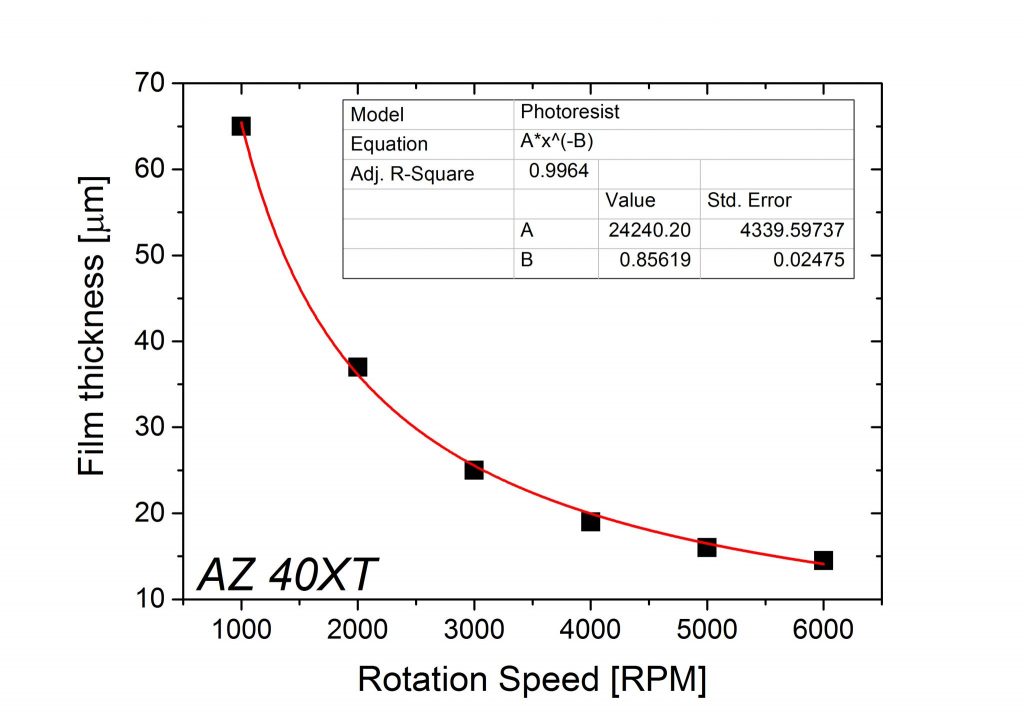
Available thicknesses: 15 um / 20 um / 30 um
| Spin speed [rpm] | Softbake time [mm:ss] | PR thickness [µm] |
|---|---|---|
| 4100, 20s | 04:30 | 15 |
| 2500, 20s | 05:00 | 20 |
| 1500, 20s | 06:00 | 30 |
Reduction of the spin time is used to control the final thickness and to achieve thicker layers compared to the usual 45s spin time. Softbake is performed with a ramp in the proximity setting to prevent the formation of bubbles during outgassing. Softbake temperature is 125°C for all options
Available options:
- HMDS / EC (edge clean)
- Dehydrate / EC
- HMDS / EBR (edge bead removal)
- Dehydrate / EBR
- Find the spin-coating speed “XXXX” [RPM] matching your target thickness from the AZ 40XT spincurve.
- When coating on wafers, use the HV_”XXXX” recipe, which includes a 500 RPM spreading step and 100 seconds of main coating step.
- When coating on small chips, use the CHIP_”XXXX” recipe, which includes 40 seconds of main coating step and a short acceleration at the end to reduce edge bead effects.
- Softbake temperature: 120°C
- Softbake time: 180” + 60”/(10um)
- To prevent bubble formation, it is recommended to deposit the wafer on the hotplate at room temperature (RT) and then let the temperature increase to 120°C.
Exposure
The following table lists the recommend dose “to clear” for AZ 40XT coated on silicon wafers. It is recommended to perform a contrast curve / exposure matrix calibration for wafers other than silicon.
| Illumination: | Broadband* | i-line (355-365 nm) | i-line (375 nm) |
|---|---|---|---|
| Equipment: | MABA6, MA6 Gen3 (no filter) | VPG 200, MA6 Gen3 (filter), MJB4 | MLA 150 |
| PR thickness [µm] | Dose [mJ/cm2]+ | Dose [mJ/cm2]++ | Dose [mJ/cm2]+++ |
| 15 | – | 300 | Refer to Resist Tables |
| 20 | – | 325 | |
| 30 | – | 365 |
* Mercury Lamp, Mask Aligner with UV400 configuration & no filter / + Based on intensity readings from Süss optometer broadband CCD / ++ Based on intensity readings from Süss optometer i-line CCD / +++ Based on MLA150 internal dose measurements
Development
The recommended developer for AZ 40XT is AZ 726 MIF (or MF CD 26), an organic solution based upon TMAH.
IMPORTANT: AZ 40XT is a chemically amplified resist and requires a post-exposure bake (PEB) before development. On automated development equipment, the PEB is included in the development sequences. For manual development, make sure to perform the PEB as indicated in the section below!
The PEB step is part of the standard development recipes on the ACS 200 system. PEB is performed at 105°C for a minimum of 100 seconds with minimum proximity gap.
Development sequences for AZ 40XT are listed below:
| Recipe name |
PR thickness [µm] |
Total contact time [s] |
|---|---|---|
| D4_PEB_40XT_15u_PUD |
15
|
80
|
| D4_PEB_40XT_20u_PUD |
20
|
110
|
| D4_PEB_40XT_30u_PUD |
30
|
150
|
Puddle method is used for the development with intermediate spin-clean steps. No Softbake is applied in order to preserve vertical PR side walls.
- ! Important! Make sure to perform the PEB at 105°C for 100 seconds before development. Use the SSE coater hotplates.
- Recommended developer: AZ 726 MIF
- Development time: 45″/10um
- Rinse: H2O 1min
IMPORTANT:
After development, it is mandatory for wafers to go through an additional rinsing step with DI water to avoid backside contamination and damage on equipments (chuck in etcher) in further processing steps. The water baths of the following wet benches can be used free of charge (5 min. billing delay after login):
- Z01 – Plade “Solvent” wet bench
- Z02 – UFT “Resist” wet bench
